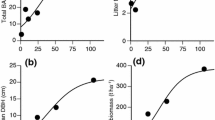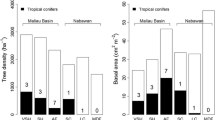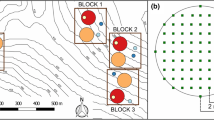Abstract
With the increase in abandoned agricultural lands in Western Europe, knowledge on the successional pathways of newly developing forests becomes urgent. We evaluated the effect of time, soil type and dominant species type (shade tolerant or intolerant) on the development during succession of three stand attributes: above-ground biomass, stand height (HT) and stem density (SD). Additionally, we compared above-ground biomass (AGB) in natural and planted forests, using ten chronosequences (8 from the literature and 2 from this study). Both AGB and HT increased over time, whereas SD decreased. HT, SD and AGB differed among species types. For example, birch had greater HT than alder, willow and ash at a similar age and had higher SD than pine and oak at a similar age. However, birch showed lower AGB than pine. HT and AGB differed among soil types. They were higher in rich soil than in poor soils. Comparative analysis between chronosequences showed an effect of the regeneration method (natural regeneration vs plantation) on above-ground biomass. Planted sites had higher AGB than natural regeneration. Time, soil type, species and regeneration method influenced the mechanism of stand responses during secondary succession. These characteristics could be used to clarify the heterogeneity and potential productivity of such spontaneously growing temperate forest ecosystems.

Similar content being viewed by others
References
Alberti G, Peressotti A, Piussi P, Zerbi G (2008) Forest ecosystem carbon accumulation during a secondary succession in the Eastern Prealps of Italy. Forestry 81(1):1–11
Bartelink H (1997) Allometric relationships for biomass and leaf area of beech (Fagus sylvatica L). Ann For Sci 54(1):39–50
Bauhus J, Paré D, Côté L (1998) Effects of tree species, stand age and soil type on soil microbial biomass and its activity in a southern boreal forest. Soil Biol Biochem 30(8–9):1077–1089
Berendse F (1990) Organic matter accumulation and nitrogen mineralization during secondary succession in heathland ecosystems. J Ecol 78(2):413–427
Berendse F, Lammerts EJ, Olff H (1998) Soil organic matter accumulation and its implications for nitrogen mineralization and plant species composition during succession in coastal dune slacks. Plant Ecol 137(1):71–78
Bungart R, Hüttl RF (2001) Production of biomass for energy in post-mining landscapes and nutrient dynamics. Biomass Bioenergy 20(3):181–187
Burnham KP, Anderson DR (2002) Model selection and multi-model inference: a practical information-theoretic approach, 2nd edn. Springer, New York
CBS PBL, Wageningen UR (2013) Emissies broeikasgassen, 1990–2012 (indicator 0165, versie 23, 9 September 2013). wwwcompendiumvoordeleefomgevingnl CBS, Den Haag; Planbureau voor de Leefomgeving, Den Haag/Bilthoven en Wageningen UR, Wageningen
Cramer VA, Hobbs RJ, Standish RJ (2008) What’s new about old fields? Land abandonment and ecosystem assembly. Trends Ecol Evol 23(2):104–112
Daamen WP, Dirkse GM (2009) 24.1 Development of the Netherlands’ National Forest Inventory. National Forest Inventories: Pathways for Common Reporting, 383p
De Kovel CGF, Van Mierlo AJEM, Wilms YJO, Berendse F (2000) Carbon and nitrogen in soil and vegetation at sites differing in successional age. Plant Ecol 149:43–50
Del Río M, Montero G, Bravo F (2001) Analysis of diameter–density relationships and self-thinning in non-thinned even-aged Scots pine stands. For Ecol Manag 142(1–3):79–87
Dirkse GM, Daamen WP, Schoonderwoerd H, Japink M, Van Jole M, Van Moorsel R, Schnitger P, Stouthamer WJ, Vocks M (2007) Meetnet Functievervulling bos 2001–2005. Vijfde Nederlandse Bosstatistiek. Ede, Directie Kennis, Ministerie van Landbouw, Natuur en Voedselkwaliteit
Elgersma AM (1998) Primary forest succession on poor sandy soils as related to site factors. Biodivers Conserv 7(2):193–206
Escudero A, JMd Arco, Sanz IC, Ayala J (1992) Effects of leaf longevity and retranslocation efficiency on the retention time of nutrients in the leaf biomass of different woody species. Oecologia 90(1):80–87
Europe F, UNECE F (2011) State of Europe's forests 2011. Status and trends in sustainable forest management in Europe. http://www.uneceorg/forests/fr/outputs/soef2011.html, p 978–982
Fanta J (1986) Forest site as a framework for forest succession. In: Fanta J (ed.), Forest dynamics research in Western and Central Europe. Wageningen Univ Pap: 58–65
Ferm A (1993) Birch production and utilization for energy. Biomass Bioenergy 4(6):391–404
Fuchs R, Herold M, Verburg PH, Clevers JGPW (2013) A high-resolution and harmonized model approach for reconstructing and analysing historic land changes in Europe. Biogeosciences 10(3):1543–1559
Gower ST, McMurtrie RE, Murty D (1996) Aboveground net primary production decline with stand age: potential causes. Trends Ecol Evol 11(9):378–382
Grashof-Bokdam C (1997) Forest species in an agricultural landscape in the Netherlands: Effects of habitat fragmentation. J Veg Sci 8(1):21–28
Grashof-Bokdam C, Geertsema W (1998) The effect of isolation and history on colonization patterns of plant species in secondary woodland. J Biogeogr 25(5):837–846
Grime JP (2002) Plant strategies, vegetation processes, and ecosystem properties, 2nd edn. John Wiley & Sons, West Sussex
Guo LB, Gifford RM (2002) Soil carbon stocks and land use change: a meta analysis. Glob Change Biol 8(4):345–360
Hamburg SP, Zamolodchikov DG, Korovin GN, Nefedjev VV, Utkin AI, Gulbe JI, Gulbe TA (1997) Estimating the carbon content of Russian forests; a comparison of phytomass/volume and allometric projections. Mitig Adapt Strat Glob Change 2(2–3):247–265
Harmon ME, Fasth B, Woodall CW, Sexton J (2013) Carbon concentration of standing and downed woody detritus: Effects of tree taxa, decay class, position, and tissue type. For Ecol Manag 291:259–267
Hees AFM (2001) Biomass development in unmanaged forests Nederlands. Bosbouwtijdschrift 73(5):2–5
Hermy M, Verheyen K (2007) Legacies of the past in the present-day forest biodiversity: a review of past land-use effects on forest plant species composition and diversity. Ecol Res 22(3):361–371
Hochbichler E (2002) Vorläufige ergebnisse von biomasseninventuren in Buchen- und Mittelwaldbeständen. In: Dietrich H-P, Raspe S, Preushsler T (eds) Inventur von Biomasse- und Nährstoffvorräten in Waldbeständen. Forstliche Forschungsberichte, Heft, 186, LWF, München, Germany, pp 37–46
Holtsmark B (2012) Harvesting in boreal forests and the biofuel carbon debt. Clim Change 112(2):415–428
Hooker TD, Compton JE (2003) Forest ecosystem carbon and nitrogen accumulation during the first century after agricultural abandonment. Ecol Appl 13(2):299–313
Hynynen J (1993) Self-thinning models for even-aged stands of Pinus sylvestris, Picea abies and Betula pendula. Scand J For Res 8(1–4):326–336
Jacob M, Leuschner C, Thomas FM (2010) Productivity of temperate broad-leaved forest stands differing in tree species diversity. Ann For Sci 67(5):503
Jandl R, Lindner M, Vesterdal L, Bauwens B, Baritz R, Hagedorn F, Johnson DW, Minkkinen K, Byrne KA (2007) How strongly can forest management influence soil carbon sequestration? Geoderma 137(3–4):253–268
Johansson T (1999a) Biomass equations for determining fractions of pendula and pubescent birches growing on abandoned farmland and some practical implications. Biomass Bioenergy 16(3):223–238
Johansson T (1999b) Dry matter amounts and increment in 21 to 91-year-old common alder and grey alder and some practical implications. Can J For Res 29(11):1679–1690
Kardol P, Martijn Bezemer T, Van Der Putten WH (2006) Temporal variation in plant–soil feedback controls succession. Ecol Lett 9(9):1080–1088
King D (2011) Size-related changes in tree proportions and their potential influence on the course of height growth. In: Meinzer FC, Lachenbruch B, Dawson TE (eds) Size- and age-related changes in tree structure and function, vol 4., Tree PhysiologySpringer, Netherlands, pp 165–191
Kint V (2005) Structural development in ageing temperate Scots pine stands. For Ecol Manag 214(1–3):237–250
Kint V, Mohren GMJ, Geudens G, de Wulf R, Lust N (2004) Pathways of stand development in ageing Pinus sylvestris forests. J Veg Sci 15(4):549–560
Kint V, Lasch P, Lindner M, Muys B (2009) Multipurpose conversion management of Scots pine towards mixed oak–birch stands—a long-term simulation approach. For Ecol Manag 257(1):199–214
Kira T, Shidei T (1967) Primary production and turnover of organic matter in different forest ecosystems of the Western Pacific. Jpn J Ecol 17(2):70–87
KNMI (Koninklijk Nederlands Meteorologisch Instituut) (2008) De toestand van het klimaat in Nederland, De Bilt KNMI 48p
Koch GW, Sillett SC, Jennings GM, Davis SD (2004) The limits to tree height. Nature 428(6985):851–854
Kuramae EE, Gamper HA, Yergeau E, Piceno YM, Brodie EL, DeSantis TZ, Andersen GL, van Veen JA, Kowalchuk GA (2010) Microbial secondary succession in a chronosequence of chalk grasslands. ISME J 4(5):711–715
Long JN, Turner J (1975) Aboveground biomass of understorey and overstorey in an age sequence of four Douglas-fir stands. J Appl Ecol 12(1):179–188
Luyssaert S, Schulze E-D, Börner A, Knohl A, Hessenmöller D, Law BE, Ciais P, Grace J (2008) Old-growth forests as global carbon sinks. Nature 455(7210):213–215
Martínez-Vilalta J, Vanderklein D, Mencuccini M (2007) Tree height and age-related decline in growth in Scots pine (Pinus sylvestris L.). Oecologia 150(4):529–544
Mazerolle MJ (2006) Improving data analysis in herpetology: using Akaike’s Information Criterion (AIC) to assess the strength of biological hypotheses. Amphibia-Reptilia 27(2):169–180
Mazerolle MJ (2011) AICcmodavg: model selection and multimodel inference based on (Q)AIC(c). R package version 117. http://cran.r-project.org/web/packages/AICcmodavg/index.html
Mitchell SR, Harmon ME, O’Connell KEB (2012) Carbon debt and carbon sequestration parity in forest bioenergy production. GCB Bioenergy 4(6):818–827
Moonen A-C, Bàrberi P (2008) Functional biodiversity: an agroecosystem approach. Agric Ecosyst Environ 127(1–2):7–21
Muukkonen P (2007) Generalized allometric volume and biomass equations for some tree species in Europe. Eur J For Res 126(2):157–166
Nabuurs G, Mohren G (1993) Carbon in Dutch forest ecosystems. NJAS Wagening J Life Sci 41(4):309–326
Nabuurs G-J, Mohren F, Dolman H (2000) Monitoring and reporting carbon stocks and fluxes in Dutch forests. Biotechnol Agron Soc Environ 4(4):308–310
Nabuurs GJ, Wyngaert IJJvd, Daamen WD, Helmink ATF, Groot WJMd, Knol WC, Kramer H, Kuikman PJ (2005) National system of greenhouse gas reporting for forest and nature areas under UNFCCC in the Netherlands. Alterra, Wageningen
Nunes L, Lopes D, Castro Rego F, Gower ST (2013) Aboveground biomass and net primary production of pine, oak and mixed pine–oak forests on the Vila Real district, Portugal. For Ecol Manag 305:38–47
Oren R, Ellsworth DS, Johnsen KH, Phillips N, Ewers BE, Maier C, Schäfer KV, McCarthy H, Hendrey G, McNulty SG (2001) Soil fertility limits carbon sequestration by forest ecosystems in a CO2-enriched atmosphere. Nature 411(6836):469–472
Øyen B-H, Blom HH, Gjerde I, Myking T, Sætersdal M, Thunes KH (2006) Ecology, history and silviculture of Scots pine (Pinus sylvestris L.) in western Norway: a literature review. Forestry 79(3):319–329
Pastor J, Post WM (1986) Influence of climate, soil moisture, and succession on forest carbon and nitrogen cycles. Biogeochemistry 2(1):3–27
Pinheiro J, Bates D, DebRoy S, Sarkar D (2011) nlme: linear and nonlinear mixed effects models. R package version 31–98. http://cran.r-project.org/web/packages/nlme/index.html. Accessed December 2011
Powers MD, Kolka RK, Bradford JB, Palik BJ, Fraver SA, Jurgensen MF (2012) Carbon stocks across a chronosequence of thinned and unmanaged red pine (Pinus resinosa) stands. Ecol Appl 22(4):1297–1307
Prach K (1989) Primary forest succession in sand dune areas, The Veluwe, Central Netherlands. Dorschkamp report no 544 Wageningen: Dorschkamppublikaties
Pregitzer KS, Euskirchen ES (2004) Carbon cycling and storage in world forests: biome patterns related to forest age. Glob Change Biol 10(12):2052–2077
Prévosto B, Kuiters L, Bernhardt-Römermann M, Dölle M, Schmidt W, Hoffmann M, Uytvanck J, Bohner A, Kreiner D, Stadler J, Klotz S, Brandl R (2011) Impacts of land abandonment on vegetation: successional pathways in European habitats. Folia Geobot 46(4):303–325
R-Development-Core-Team (2011) R: a language and environment for statistical computing. R Foundation for Statistical Computing, Vienna, Austria. ISBN 3- 900051-07-0, Available from, http://www.R-project.org/. Accessed December 2011
Ryan MG, Yoder BJ (1997) Hydraulic limits to tree height and tree growth. Bioscience 47(4):235–242
Ryan MG, Binkley D, Fownes JH (1997) Age-related decline in forest productivity: pattern and process. In: Begon M, Fitter AH (eds) Advances in Ecological Research, vol 27. Academic Press, pp 213–262
Schulp CJE, Nabuurs G-J, Verburg PH (2008) Future carbon sequestration in Europe: effects of land use change. Agric Ecosyst Environ 127(3–4):251–264
Stoate C, Báldi A, Beja P, Boatman ND, Herzon I, van Doorn A, de Snoo GR, Rakosy L, Ramwell C (2009) Ecological impacts of early 21st century agricultural change in Europe: a review. J Environ Manag 91(1):22–46
Vande Walle I, Van Camp N, Van de Casteele L, Verheyen K, Lemeur R (2007) Short-rotation forestry of birch, maple, poplar and willow in Flanders (Belgium) I: biomass production after 4 years of tree growth. Biomass Bioenergy 31(5):267–275
Vesterdal L, Ritter E, Gundersen P (2002) Change in soil organic carbon following afforestation of former arable land. For Ecol Manag 169(1–2):137–147
Vesterdal L, Rosenqvist L, Van der Salm C, Hansen K, Groenenberg B-J, Johansson M-B (2007) Carbon sequestration in soil and biomass following afforestation: experiences from oak and Norway spruce chronosequences in Denmark, Sweden and the Netherlands. In: Heil GW, Muys B, Hansen K (eds) Environmental effects of afforestation in North-Western Europe. Springer, pp 19–51
Acknowledgments
Thanks to Dr. L. Vesterdal and his colleagues for helping us with information and data on his paper Vesterdal et al. (2007). We are also grateful for Dr. M. D. Powers and USDA forest service Northern Research Station for helping us with information and data on article Powers et al. (2012). A. K. Bose was a recipient of an ERASMUS MUNDUS master scholarship provided by the University of Eastern Finland and Wageningen University, the Netherlands.
Conflict of interest
We declare that we have no conflict of interest.
Author information
Authors and Affiliations
Corresponding author
Additional information
Communicated by C. Ammer.
Appendix
Appendix
See Table 6.
Rights and permissions
About this article
Cite this article
Bose, A.K., Schelhaas, MJ., Mazerolle, M.J. et al. Temperate forest development during secondary succession: effects of soil, dominant species and management. Eur J Forest Res 133, 511–523 (2014). https://doi.org/10.1007/s10342-014-0781-y
Received:
Revised:
Accepted:
Published:
Issue Date:
DOI: https://doi.org/10.1007/s10342-014-0781-y




